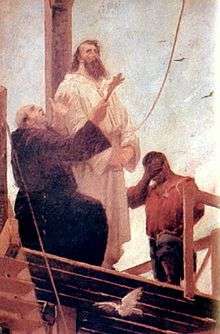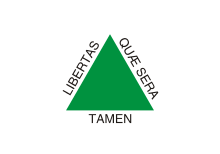Tiradentes
| Joaquim José da Silva Xavier (Tiradentes) | |
|---|---|
 Joaquim José da Silva Xavier, known as Tiradentes, being hanged. | |
| Born |
November 12, 1746 Fazenda do Pombal (Tiradentes), Minas Gerais, Portuguese Colony of Brazil |
| Died |
April 21, 1792 (aged 45) Rio de Janeiro, Portuguese Colony of Brazil |
| Other names | Tiradentes |
| Movement | Inconfidência Mineira |
Joaquim José da Silva Xavier ([ʒwaˈkĩ ʒuˈzɛ dɐ ˈsiwvɐ ʃɐviˈɛʁ]; November 12, 1746 – April 21, 1792), known as Tiradentes (IPA: [tʃiɾɐˈdẽtʃis]), was a leading member of the Brazilian revolutionary movement known as the Inconfidência Mineira whose aim was full independence from the Portuguese colonial power and to create a Brazilian republic. When the plan was discovered, Tiradentes was arrested, tried and publicly hanged. Since the 19th century he has been considered a national hero of Brazil and patron of the Military Police.[1]
Family and early occupation
Born to a poor family in a farm in Pombal, Ritápolis, near to São João del Rey, Minas Gerais, Tiradentes was adopted by his godfather and moved to Vila Rica (now Ouro Preto) after the deaths of his parents (mother in 1755; father in 1757).[2]
Tiradentes was raised by a tutor, who was a surgeon. His lack of formal education didn't stop him from working in several fields, including dental medicine; Tiradentes means "tooth puller",[3] a pejorative denomination adopted during the trial against him. He practiced several professions—cattle driver, miner, dentist—and was a member of the Minas Gerais Dragoon Regiment. As Tiradentes was not a member of the local aristocracy, he was systematically overlooked for promotion and never rose above the rank of alferes (2nd lieutenant).
Political ideas
Living in a state rich in gold, Tiradentes used the knowledge he acquired about minerals to enter the public service (he achieved the ranks of alferes, low in the hierarchy of the epoch), and he was sent to missions in cities along the road between Vila Rica (the capital of Minas Gerais) and Rio de Janeiro; this road was the "open vein" used to export most of the gold to Portugal.
Tiradentes soon noticed the exploitation to which Brazilians were subjected; he saw how much gold, and other valuable resources were being pillaged for export to Portugal.


His trips to Rio put him in contact with people who had lived in Europe and brought from there the liberal ideas (The English North American colonies had become independent in 1776, and French Revolution would be in 1789, the "cauldron" of freedom was "hard boiling"). In 1788, Tiradentes met José Alvares Maciel, son of the governor of Vila Rica, who had just returned from England; they could compare the British industrial progress with the Brazilian colonial poverty. They created a group of freedom aspirers, led by clerics and other Brazilians with some social presence, like Cláudio Manuel da Costa (staff of government and important writer), Tomás Antônio Gonzaga (staff of government) and Alvarenga Peixoto (eminent businessman); the group propagated their ideas among Brazilians.
At that time, Portugal was hungry for gold; however, the production of Brazilian mines was declining. The Brazilians were not meeting the yearly quota of gold that was requested by the crown, and there was pressure from Portugal to ensure all the due taxes were paid. The days of payment of taxes were called derrama.
Influenced by the writings of Rousseau, and by the American Revolution, Tiradentes joined with a number of like-minded citizens in the Inconfidência Mineira. They wanted a separate republic with its capital at São João del Rei and to set a university. The proposed flag for the new republic was white with a green triangle surrounded by the Latin motto "Libertas Quae Sera Tamen" ("Liberdade ainda que tardia", Portuguese for "Freedom, Even If It Be Late"). The flag later became the state flag of Minas Gerais, the only modification was the color of the triangle which was changed to red.
Discovery, trial and execution
Tiradentes' plan was to take to the streets of Vila Rica on the day of derrama in February 1789, when tax was due to Portugal and the sentiment of revolt among Brazilians would be stronger, and proclaim a Brazilian Republic. However, the movement was disclosed to the governor, who canceled the derrama and ordered the imprisonment of the rebels. Joaquim Silverio dos Reis, a member of the movement, betrayed the group in exchange for waiving of his taxes.
_by_Pedro_Am%C3%A9rico_1893.jpg)
Tiradentes fled to Rio, where he tried to reorganize the movement. Not knowing what dos Reis had done, Tiradentes went to meet him. Tiradentes was arrested on May 10, 1789.
The trial lasted almost three years. Tiradentes assumed complete responsibility for the movement. Ten members of the group were sentenced to death, but Queen Maria I of Portugal commuted all the sentences, except that of Tiradentes, from death to degradation.
On April 21, 1792 (today the date of a national holiday in Brazil), Tiradentes was hanged in Rio de Janeiro, in the plaza today named Praça Tiradentes. His body was quartered into several pieces. With his blood, a document was written declaring his memory infamous. His head was publicly displayed in Vila Rica and pieces of his body were exhibited in the cities between Vila Rica and Rio to terrorize the populace and those who had sympathized with Tiradentes' ideas of independence.
National hero
He began to be considered a national hero by the republicans in the late 19th century, and after the republic was proclaimed in Brazil in 1889 the anniversary of his death (April 21) became a national holiday.
As of now there is a city in the state of Minas Gerais bearing his name, city squares in Belo Horizonte, Curitiba, São Paulo, Rio de Janeiro, and Ouro Preto, as well as a major avenue in the Dominican Republic.
References
- ↑ "PM Antecipa homenagem a Tiradentes, patrono cívico do Brasil". Alerj. Retrieved August 8, 2014.
- ↑ "Tiradentes". Brasil Escola. Retrieved August 8, 2014.
- ↑ from the Portuguese words tirar (to take or remove) and dentes (teeth)
Further reading
- Maxwell, Kenneth R, Conflicts and Conspiracies: Brazil & Portugal 1750-1808 (Cambridge University Press, 1973) ISBN 0-521-20053-9
External links
| Wikimedia Commons has media related to Tiradentes. |
- Museu da Inconfidência
- Tiradentes at about.com
- Tiradentes at e-Biografias